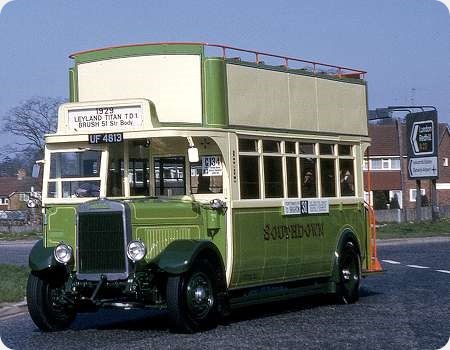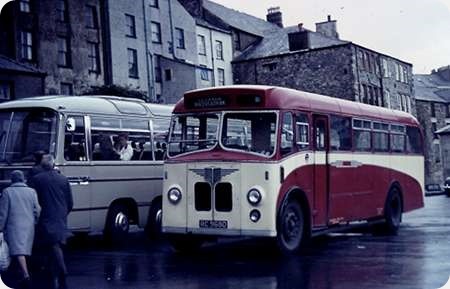
Sheffield Corporation
1952
AEC Regal IV
Roe B44F
Sheffield 13 (originally 213) is passing a splendid array of shop fronts in Haymarket, Sheffield on a midday 29 to Blackburn (in Rotherham – not Lancashire). This was a works service to Shardlows Works midway between Sheffield and Rotherham. A low bridge required the use of single deckers. I cannot recall seeing a bus on this service showing a destination so presumably was not on the standard blinds. An oddity of this bus by this date (August 1967) was the plain cream front presumably after an accident damage repair. As delivered it had a City of Oxford style swoop painted blue a feature which was retained by sisters 12 and 14 to the end of their service life. I used to chat to a Greenland Depot Fitter when he worked at Greyhound in Sheffield on a Saturday afternoon. I recall him saying how unreliable these three buses were with repeated clutch and door failures. He told me one Bank Holiday weekend all three were sent on Peak District extras and all three had to be towed back to garage.
Photograph and Copy contributed by Ian Wild
Quick links to the - Comments Page - Contact Page - Home Page

Southdown Motor Services
1929
Leyland Titan TD1
Brush O27/24RO
Seen at the Southgate roundabout on the A23 Crawley By Pass during the 3rd May 1970 HCVC Rally is UF 4813, a 1929 Leyland Titan TD1 with the Brush open top O27/24RO open staircase body that it carried from new – it is not a conversion. It was restored by Southdown who ran it on the Brighton seafront service for some years, and it currently remains with the Stagecoach heritage fleet. The TD1 model, very advanced when it appeared in 1927, had a six cylinder 6.8 litre overhead camshaft petrol engine of up to 98 bhp driving through a four speed sliding mesh gearbox. Most examples were bodied with the Leyland lowbridge body, the firm initially holding the UK royalty rights for the single offside gangway upper deck layout. Until these patent rights expired in the mid ‘thirties, other manufacturers employed the twin gangway form of the upper deck for lowbridge orders. AEC initially used the ‘camel roof’ design on its highbridge Regent buses purely for cosmetic effect to give a low height appearance from street level, but this was soon abandoned as public acceptance grew of the stability of double deck buses. UF 4813 carries the radiator design of 1929 that then became familiar on all subsequent TD1 and the later TD2 machines. Earlier production retained the radiator shape of the Leviathan.
Photograph and Copy contributed by Roger Cox
Quick links to the - Comments Page - Contact Page - Home Page

Express Motors
1947
AEC Regal I 0662
Willowbrook rebody 1958 FDP39F
RC 9680 was new to Trent in 1947 with a Willowbrook B35F body being lengthened and fitted with a new Willowbrook body in 1958. It was withdrawn by Trent in 1963 and is shown here four years later laying over in the shadow of Caernarvon Castle on a wet day in September 1967.
Photograph and Copy contributed by Ian Wild
21/07/20 – 06:41
A small correction to Ian’s caption; these vehicles were not given new Willowbrook bodies, the original bodies were lengthened at the rear to allow an extra double seat on each side and slightly at the front to fully enclose the cab and conceal the radiator. The other modification was a folding door, as seen, replacing the previous porch type entrance with a door at the top of the steps.
There were twenty of these conversions, the first one was given all new flush glazed windows mounted in rubber gasket, the remainder kept their original windows to reduce the conversion cost. They were all given new seats which allowed them to be re-classified as dual purpose but the new seats, although an improvement, were still rather spartan for 2-3 hour seaside services.
Chris Barker
22/07/20 – 06:58
It was a very successful conversion, IMHO, helped by the completely horizontal waistline instead of the dropping rear. I wouldn’t have guessed the bodywork wasn’t original. And here it is, still around, 20 years after being built!
Chris Hebbron
25/07/20 – 07:15
I agree with Chris Barkers comment about the horizontal waste line, helping to give the vehicle a more modern appearance. However when I see these vehicles I always feel that the frontal appearance could have been improved if – either the aluminium trim followed the bottom contour of the front windows, (and not a horizontal line) or the windows had a horizontal base instead of the angled finish. I’m sure their were good reasons for not altering the line of the windows (not least because they concealed the bulkhead and radiator and were part of the original half cab design). Nice conversion in any event.
John Rentell
09/08/20 – 05:53
Looks like a Creams (of Llandudno) Bedford VAL alongside. Could be BCC 1C ( https://flic.kr/p/7Qrw3K ), or BCC 6C.
David Williamson
Quick links to the - Comments Page - Contact Page - Home Page



